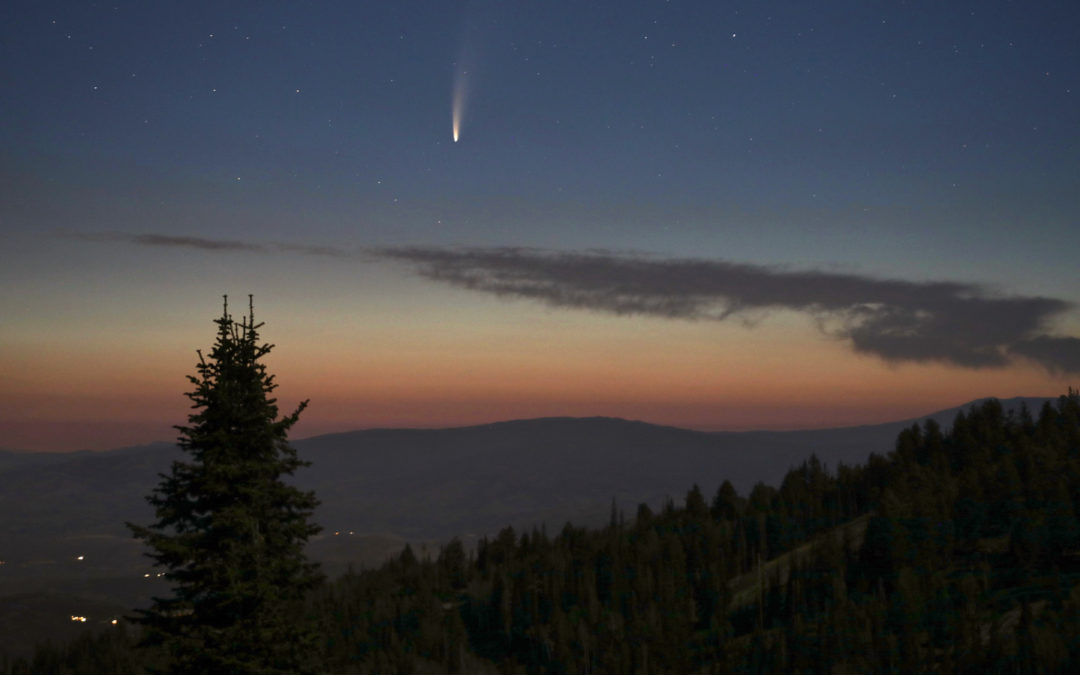Comets come; comets go. Most of them are too dim to be seen. Occasionally, one will come close enough to be visible. Some of us remember comet Hale-Bopp that provided a spectacular view in 1997.
Comet C/2020 F3, aka NEOWISE, has passed by the Sun and is heading back out into space. But for a short time, it will (we hope) be visible to those of us on the Earth!
NEOWISE has appeared in the morning sky low in the northeastern horizon well below the bright star Capella in the constellation Auriga. As we move into mid-July, it will reappear in the northwest evening sky near the Big Dipper. Sky & Telescope has a nice map showing the position of the comet from the 14th through the 23rd.
- Around the 14th follow the handle through the bowl of the Big Dipper and down about the same distance to find the comet.
- Over the next few nights, it will move higher and a bit to the left of the Big Dipper.
- Its closest approach to the Earth will be on the evening of July 23 when it begins to move under the bowl. Draw a line down between the two end stars of the bowl (Dubhe to Merak) and extend it twice that distance to find the comet.
- Late in the month, it will move higher in the sky passing under the bowl and then the under the tail while maintaining a distance from the Dipper of two to three times the distance between the two end stars of the bowl (Dubhe to Merak).
Although it is technically a “naked eye” comet, dark skies along with binoculars or a telescope will probably be required to see any detail. But you never know, NEOWISE could surprise us. Take a look and see if you can find it.
Comets are chunks of rock and ice that travel on long elliptical orbits. If you happen to miss the comet this time around, don’t worry. It will return in around 6,800 years. Mark your calendar.
Sources for Additional Reading
- Bob King. “Comet Neowise Delights at Dawn.” Sky & Telescope. July 9, 2020. https://skyandtelescope.org/astronomy-news/observing-news/comet-neowise-delights-at-dawn/
- “Comet Neowise C/2020 F3.” Comet Watch. June 28, 2020. http://www.cometwatch.co.uk/comet-neowise-c-2020-f3/
- Eddie Irizarry. “How to see Comet NEOWISE. EarthSky. July 10, 2020. https://earthsky.org/space/how-to-see-comet-c2020-f3-neowise
- Jamie Carter. “How to See Comet NEOWISE From Your Backyard This Week.” Forbes. July 6, 2020. https://www.forbes.com/sites/jamiecartereurope/2020/07/06/how-to-see-comet-neowise-from-your-backyard-this-week/#67daf222496f
- Mark Zastrow. “Comet C/2020 F3 (NEOWISE) springs a naked-eye surprise.” Astronomy. July 6, 2020. https://astronomy.com/news/2020/07/comet-c2020-f3-neowise-springs-a-naked-eye-surprise
- Stuart Atkinson. “See Comet NEOWISE in the sky this month.” BBC Sky at Night. July 6, 2020. https://www.skyatnightmagazine.com/advice/skills/how-to-see-comet-c-2020-f3-neowise/
- Joe Haberthier. C/2020 F3 (NEOWISE) Photo. July 10, 2020. https://joehaberthier.smugmug.com/Astronomy/i-8TR5qVJ/A


Recent Comments